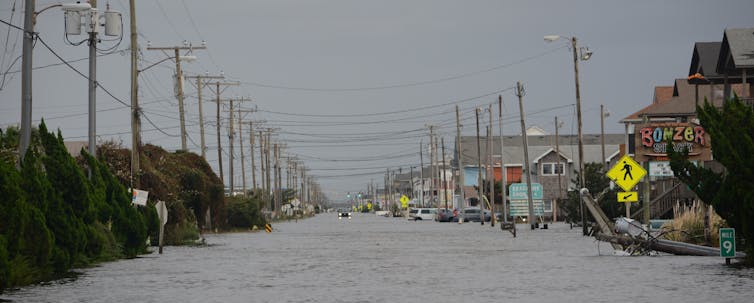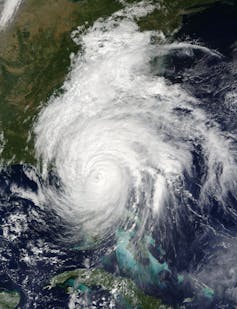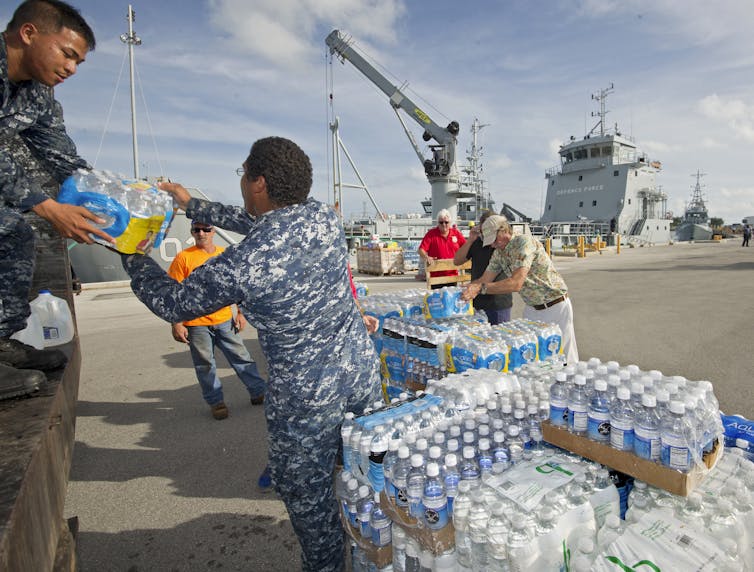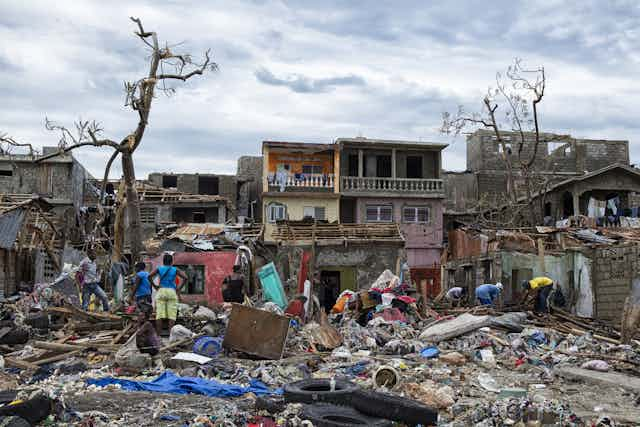Hurricane Matthew, the Atlantic’s first Category 5 storm in almost a decade, slammed into Haiti on October 4. Strong winds left a path of death and destruction through the island, with at least 1,000 people already confirmed dead and more than 2m of the island’s 10m population affected. Now there are warnings of famine and cholera.
Haitians, however, are no strangers to disaster. A 2010 earthquake left at least 100,000 dead and a subsequent cholera outbreak affected many more. Flooding in 2004 also killed thousands. And those are just the major events that make it into the global media. For most people in Haiti, so-called “natural disasters” are a recurrent theme in their lives.
In the US, however, it’s a different story. Hurricane Matthew reached Florida two days later and ran along the coast to North and South Carolina, killing at least 33. Though the storm slowed as it made its way across the Caribbean, the difference in death numbers is not coincidental: natural disasters remain disproportionately a hazard of the poor.

Globally, the number of deaths from disasters is falling. However, they still have the most debilitating effects in developing countries, where population growth, the burgeoning of shanty towns and land degradation all add to the risk.
Disaster statistics in the developed world tell a completely different story, in which the number of fatalities proportional to the total population has declined dramatically in recent decades. There, building and zoning codes are typically well-enforced, structures are retrofitted to withstand hazards, emergency services are better equipped, and early warning systems have become increasingly sophisticated. All this has reduced human losses, even if the cost in material terms increased at least eightfold in the last four decades of the 20th century.
Natural disasters have come to mean two very different types of events depending on where you are in the world. British prime minister Benjamin Disraeli famously spoke of “two nations” who are “as ignorant of each other’s habits, thoughts, and feelings, as if they were dwellers in different zones, or inhabitants of different planets”. Disraeli was talking about Victorian Britain, but the same might be said about the “two worlds” that have come to separate people in the developed and developing countries in terms of wealth, life expectancy and exposure to risk. For one, disaster is now principally about economic loss, and for the other it remains primarily about loss of life.

Two worlds
The root of this separation lies in the way disasters are perceived. In the developed world, disasters are viewed as abnormal events, a temporary disruption in everyday lives and where a return to “normality” is confidently expected. On October 9, for instance, two days after the storm peaked in Florida, the state’s governor announced the national guard would help schools reopen as quickly as possible.
In the developing world, disasters are seen as normal everyday events that people have had to learn to live with. So normal, in fact, that society and culture are partly the product of adapting to their frequent occurrence.
This fault line also extends to the nature of the state. The developed world is governed by strong states that “nationalise” disasters, disempower their citizens and absolve them of responsibility for their own personal safety. The state in developing countries, however, is fundamentally weaker without the institutional and infrastructural capacity to provide for the needs of its citizens. As a result, communities are stronger, made more self-reliant through neglect and default. Trust is at the local level, expressed in terms of families, friends and neighbourhoods.
For the inhabitants of one world, disasters have become primarily a state affair; for the inhabitants of the other, they are a community concern.

In the developed world, disaster mitigation is primarily a matter of science and technology and the numerical modelling of risk. However, for those in the developing world, disaster preparedness is generally about people: educating, training and organising them; relying on them to take care of themselves, because the state does not possess the resources for technological solutions.
Different sets of priorities
Developed countries are increasingly concerned with protecting property and sensitive structures like costly skyscrapers or nuclear power plants. Disaster is largely calculated in property damage – “Hurricane Matthew economic damage nears $6 billion”.
While the material damage inflicted on developing countries can be immense in relative terms, disaster is still measured in lost lives. Governments remain primarily concerned with saving people. Priorities, therefore, are often at odds: Western advice is frequently regarded as impractical or irrelevant by many in developing countries.
Moreover, much Western-funded reconstruction and aid is tied to a set of externally imposed guidelines frequently espousing neoliberal values that can make matters worse by channelling scarce resources into inappropriate projects. This “development aggression” leaves people more exposed to risk by ignoring community needs and treating local people mainly as passive recipients or as a profit-making resource.
As a result of differences in both what disasters mean and the way to tackle them, the communitarian and organisational skills of people in developing countries are often unfairly dismissed and ignored. The emphasis on low-cost, low-tech solutions that stress living with risk and encouraging self-reliance is regarded by professionals in developed countries as a response to the absence of state services rather than as the bedrock of what makes communities resilient.
Such attitudes make for an uncertain future as climate change and population growth affect both the magnitude and frequency of extreme events. Disraeli’s two “nations” have become “two worlds”. As disasters like Hurricane Matthew become more commonplace, all of us may be forced to rely less on state services and costly defences and more on ourselves and our neighbours.

